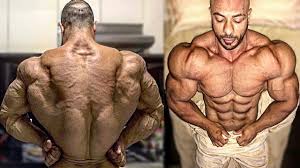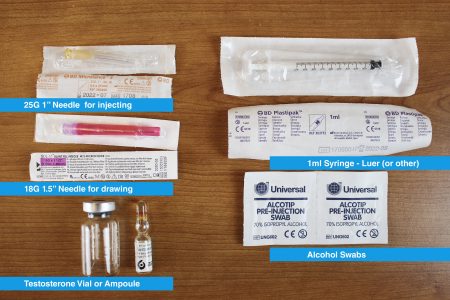reclaim your mojo
A Testosterone therapy Guide for men:
<header class="entry-header" style="box-sizing: border-box; color: rgb(45, 45, 45); font-family: "Titillium Web", sans-serif; font-size: 18px;"></header>
Testosterone levels naturally decrease as men age, so maintaining healthy testosterone levels is imperative for ensuring longevity and wellness. There are many reasons testosterone is so intensively researched, with findings demonstrating that this key steroid hormone has a multitude of anabolic properties in the human body.
For example, research shows that testosterone potently inhibits amino acid oxidation and increases skeletal muscle protein synthesis.[1] In layman’s terms, this means testosterone helps maintain (and build) lean body mass. If you're not seeing results in the gym despite a proper diet plan and exercise regimen, you might have low T.
And that’s just the tip of the iceberg...
Testosterone is quite literally what makes a man masculine. Hair growth, muscular size, jawline shape, voice pitch, libido, confidence, metabolism, bone density, the list goes on - it’s all related to testosterone in some capacity. As such, testosterone is characterized as an anabolic androgenic steroid (AAS).
Similar to human growth hormone (HGH), a myriad of factors affect your endogenous production of testosterone - positively or negatively. These factors typically include:
Positive regulators (these generally increase testosterone)
Symptoms of low testosterone:
1) Bitches Be Like Disgusted



The list below details the most common signs and symptoms of having low T:
It’s important to note that while you may exhibit several (or all) of these symptoms, you should confirm that you have low T with proper blood work. A trained physician at Gameday Men’s Health can help order the appropriate lab tests and guide you through the process of restoring your testosterone to healthy levels.
WHAT TO EXPECT ON TRT

If you’ve made the choice to start testosterone replacement therapy (TRT), you might be wondering what to expect throughout the process of getting your “manhood” back.
Depending on the form of testosterone used, many men notice a reduction of low T symptoms within as little as one month on TRT. For some, it may take longer before improvements in health and well-being become apparent. Several weeks or months might sound like a long time, but in the grand scheme of things, that’s actually very quick. It’s key to remember that TRT is a long-term solution to an otherwise long-term health problem.
Research suggests that the short-term benefits of TRT may include a heightened sense of vitality, increased libido, enhanced energy levels, more restful sleep, and other positive changes.[2] The vast majority of TRT patients find that the initial waiting period for testosterone to kick in is well worth the wait.
WHAT THE PROCESS IS LIKE TO GET STARTED
The first order of business for starting TRT is to contact Gameday Men’s Health and schedule an initial consultation. During the initial appointment, you will be asked to detail your symptoms and learn more about what TRT does.
We require blood work from all prospective patients. This allows us to assess the quantitative values of your testosterone (and possibly other associated assays). It's essential to have blood work done before and during TRT to ensure your red blood cell counts, blood lipids, prostate-specific antigen, and other relevant biomarkers are in a healthy range.
Having a licensed physician oversee the process of starting TRT should put your mind at ease, though, as they are trained to properly medicate you and minimize side effects/health ramifications. If your blood work suggests you have suboptimal testosterone levels, you will likely be considered a viable candidate for TRT.
Should you move forward with beginning TRT through GameDay Men's Health, you will be given a shot of testosterone and taught how to inject yourself for future doses. Alternatively, you may come to the GameDay office for quick and easy weekly TRT injections.
WHAT you feel LIKE after you INJECT YOURSELF

Afraid of needles? Don’t worry, injections are not nearly as petrifying as they may seem at first. We're not trying to sugarcoat this process, because injections are certainly a hurdle for many beginners on TRT. Even those who have been on TRT for years still have a little apprehension when it comes time to inject themselves.
In reality, though, the gauge of the needle is very small when injecting testosterone; once you get past the initial puncturing of the skin, the needle will glide smoothly into your muscle tissue without much sensation at all. The best advice is to take deep breaths and be steady when inserting the needle.
Intuitively, you might just think that jabbing the needle in as fast as possible will bypass any sort of sensation you might feel, but that’s also not a very controllable approach. Use a firm grip on the barrel of the syringe, breath, and firmly penetrate your skin. The needle will smoothly glide into your muscle, at which point you will apply pressure to the plunger and dispense the testosterone. (Your muscle might twitch slightly but it’s not a painful sensation for most people, more so a reflex.)
The entire injection process generally takes no more than 15 seconds. Always be sure to maintain a sterile environment. Wipe the injection spot with an alcohol wipe beforehand to disinfect the skin and do not reuse needles or syringes as this greatly increases the risk of infections.
When you inject testosterone, you’re putting a depot of oil into muscle tissue which is slowly dispersed into the bloodstream (for several days, or even weeks, depending on the ester). As a side effect of this, you might experience injection site soreness for a few days after the fact. Don’t worry, though; this is completely normal and subsides on its own. Massaging the muscle and applying a warm gel pack for 5-10 minutes can also help alleviate any soreness or stiffness at the injection site.
DO I HAVE TO INJECT MYSELF ON TRT?
If you have trouble injecting yourself, GameDay Men's Health offers in-and-out injection appointments to our TRT patients. This is the most common option for many newcomers to TRT since you can just close your eyes and let us do the injection for you.
You may also ask a friend or family member to help with the first few injections if you prefer to do them at home.
In the long-term, it behooves you to become comfortable with doing TRT injections by yourself. It’s not always practical to find someone to inject you, especially if you live alone or want to maintain privacy about your TRT.
Just breathe and relax, you got this.
Testosterone Replacement Therapy HRT Quad Injection Protocol
A full guide on how to do a pain-free quad injection safely, for testosterone replacement therapy or other condition . I cover the equipment needed, needle sizes, exact injection site/area on the quad and more.
Trying something new for the first time can be terrifying, especially when it involves your health, or worse, potentially blood! Quad injections were no different for me.
However, I soon learnt that they were extremely safe and simple to do, and that I had overreacted (as usual). In fact, they were easier to perform than glute injections.
Quad injections are the second most commonly used form of intramuscular injection for testosterone replacement therapy. The most common is glute injections.
Sometimes you may wish to give your glute muscles a break, which is where quad injections come in handy.
Quad injections are also easier to perform. Your quadricep muscles on your leg are right in front of you and are easier to access, compared to your glutes (bum), which involves twisting awkwardly to reach.
In today’s video, I give a full breakdown and demonstration of how to do a quad injection safely and painlessly.
 TRT QUAD INJECTION
TRT QUAD INJECTION
I cover and demonstrate the following areas:

A Testosterone therapy Guide for men:
<header class="entry-header" style="box-sizing: border-box; color: rgb(45, 45, 45); font-family: "Titillium Web", sans-serif; font-size: 18px;"></header>
Testosterone levels naturally decrease as men age, so maintaining healthy testosterone levels is imperative for ensuring longevity and wellness. There are many reasons testosterone is so intensively researched, with findings demonstrating that this key steroid hormone has a multitude of anabolic properties in the human body.
For example, research shows that testosterone potently inhibits amino acid oxidation and increases skeletal muscle protein synthesis.[1] In layman’s terms, this means testosterone helps maintain (and build) lean body mass. If you're not seeing results in the gym despite a proper diet plan and exercise regimen, you might have low T.
And that’s just the tip of the iceberg...
Testosterone is quite literally what makes a man masculine. Hair growth, muscular size, jawline shape, voice pitch, libido, confidence, metabolism, bone density, the list goes on - it’s all related to testosterone in some capacity. As such, testosterone is characterized as an anabolic androgenic steroid (AAS).
Similar to human growth hormone (HGH), a myriad of factors affect your endogenous production of testosterone - positively or negatively. These factors typically include:
Positive regulators (these generally increase testosterone)
[*=left]Sufficient sleep
[*=left]Healthy body composition (leanness)
[*=left]Intense exercise (especially vigorous resistance training)
[*=left]Intermittent abstinence (up to 10 days)
[*=left]Obesity
[*=left]Diabetes (specifically insulin-resistant/type II diabetes)
[*=left]Excessive alcohol intake
[*=left]Very-low-fat diet (fat is necessary for synthesizing androgens)
[*=left]Xenobiotics
[*=left]Lack of sleep
[*=left]Chronic stress
[*=left]Sedentary lifestyle
[*=left]Prolonged cardiovascular (aerobic) exercise
Symptoms of low testosterone:
1) Bitches Be Like Disgusted


The list below details the most common signs and symptoms of having low T:
[*=left]Erectile dysfunction (impotence)
[*=left]Reduced libido/sex drive
[*=left]Decreased energy (fatigue)
[*=left]Reduced muscle bulk and strength
[*=left]Depression
[*=left]Small or shrinking testes
[*=left]Poor concentration (brain fog) and recall
[*=left]Low red blood cell count (anemia)
[*=left]Brittle bones and general weakness
[*=left]Hot flashes
[*=left]Infertility
[*=left]Body fat increase
[*=left]Loss of body and pubic hair
[*=left]Sleep apnea (or other sleep disorders)
[*=left]Development of breast tissue (gynecomastia)
It’s important to note that while you may exhibit several (or all) of these symptoms, you should confirm that you have low T with proper blood work. A trained physician at Gameday Men’s Health can help order the appropriate lab tests and guide you through the process of restoring your testosterone to healthy levels.
WHAT TO EXPECT ON TRT
If you’ve made the choice to start testosterone replacement therapy (TRT), you might be wondering what to expect throughout the process of getting your “manhood” back.
Depending on the form of testosterone used, many men notice a reduction of low T symptoms within as little as one month on TRT. For some, it may take longer before improvements in health and well-being become apparent. Several weeks or months might sound like a long time, but in the grand scheme of things, that’s actually very quick. It’s key to remember that TRT is a long-term solution to an otherwise long-term health problem.
Research suggests that the short-term benefits of TRT may include a heightened sense of vitality, increased libido, enhanced energy levels, more restful sleep, and other positive changes.[2] The vast majority of TRT patients find that the initial waiting period for testosterone to kick in is well worth the wait.
WHAT THE PROCESS IS LIKE TO GET STARTED
The first order of business for starting TRT is to contact Gameday Men’s Health and schedule an initial consultation. During the initial appointment, you will be asked to detail your symptoms and learn more about what TRT does.
We require blood work from all prospective patients. This allows us to assess the quantitative values of your testosterone (and possibly other associated assays). It's essential to have blood work done before and during TRT to ensure your red blood cell counts, blood lipids, prostate-specific antigen, and other relevant biomarkers are in a healthy range.
Having a licensed physician oversee the process of starting TRT should put your mind at ease, though, as they are trained to properly medicate you and minimize side effects/health ramifications. If your blood work suggests you have suboptimal testosterone levels, you will likely be considered a viable candidate for TRT.
Should you move forward with beginning TRT through GameDay Men's Health, you will be given a shot of testosterone and taught how to inject yourself for future doses. Alternatively, you may come to the GameDay office for quick and easy weekly TRT injections.
WHAT you feel LIKE after you INJECT YOURSELF

Afraid of needles? Don’t worry, injections are not nearly as petrifying as they may seem at first. We're not trying to sugarcoat this process, because injections are certainly a hurdle for many beginners on TRT. Even those who have been on TRT for years still have a little apprehension when it comes time to inject themselves.
In reality, though, the gauge of the needle is very small when injecting testosterone; once you get past the initial puncturing of the skin, the needle will glide smoothly into your muscle tissue without much sensation at all. The best advice is to take deep breaths and be steady when inserting the needle.
Intuitively, you might just think that jabbing the needle in as fast as possible will bypass any sort of sensation you might feel, but that’s also not a very controllable approach. Use a firm grip on the barrel of the syringe, breath, and firmly penetrate your skin. The needle will smoothly glide into your muscle, at which point you will apply pressure to the plunger and dispense the testosterone. (Your muscle might twitch slightly but it’s not a painful sensation for most people, more so a reflex.)
The entire injection process generally takes no more than 15 seconds. Always be sure to maintain a sterile environment. Wipe the injection spot with an alcohol wipe beforehand to disinfect the skin and do not reuse needles or syringes as this greatly increases the risk of infections.
When you inject testosterone, you’re putting a depot of oil into muscle tissue which is slowly dispersed into the bloodstream (for several days, or even weeks, depending on the ester). As a side effect of this, you might experience injection site soreness for a few days after the fact. Don’t worry, though; this is completely normal and subsides on its own. Massaging the muscle and applying a warm gel pack for 5-10 minutes can also help alleviate any soreness or stiffness at the injection site.
DO I HAVE TO INJECT MYSELF ON TRT?
If you have trouble injecting yourself, GameDay Men's Health offers in-and-out injection appointments to our TRT patients. This is the most common option for many newcomers to TRT since you can just close your eyes and let us do the injection for you.
You may also ask a friend or family member to help with the first few injections if you prefer to do them at home.
In the long-term, it behooves you to become comfortable with doing TRT injections by yourself. It’s not always practical to find someone to inject you, especially if you live alone or want to maintain privacy about your TRT.
Just breathe and relax, you got this.
Testosterone Replacement Therapy HRT Quad Injection Protocol
A full guide on how to do a pain-free quad injection safely, for testosterone replacement therapy or other condition . I cover the equipment needed, needle sizes, exact injection site/area on the quad and more.
Trying something new for the first time can be terrifying, especially when it involves your health, or worse, potentially blood! Quad injections were no different for me.
However, I soon learnt that they were extremely safe and simple to do, and that I had overreacted (as usual). In fact, they were easier to perform than glute injections.
Quad injections are the second most commonly used form of intramuscular injection for testosterone replacement therapy. The most common is glute injections.
Sometimes you may wish to give your glute muscles a break, which is where quad injections come in handy.
Quad injections are also easier to perform. Your quadricep muscles on your leg are right in front of you and are easier to access, compared to your glutes (bum), which involves twisting awkwardly to reach.
In today’s video, I give a full breakdown and demonstration of how to do a quad injection safely and painlessly.

I cover and demonstrate the following areas:
- The medical supplies needed for an intramuscular quad injection
- The quad injection site
- Preparing the testosterone, syringe and needle for the injection
- Injecting the testosterone and cleaning up

Last edited:




